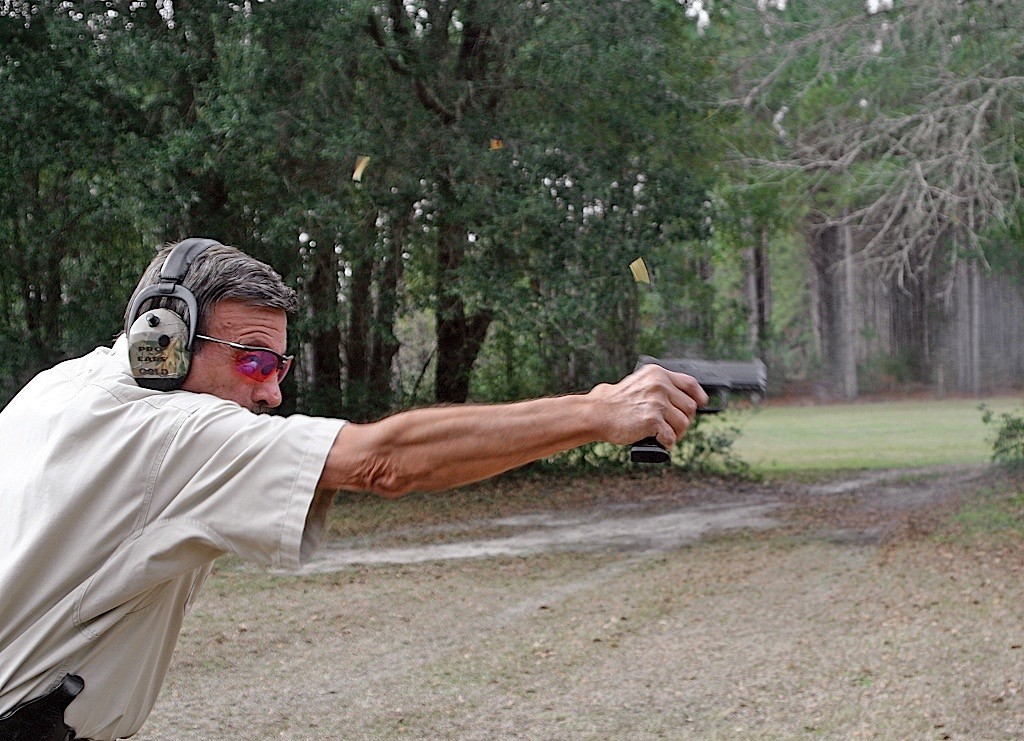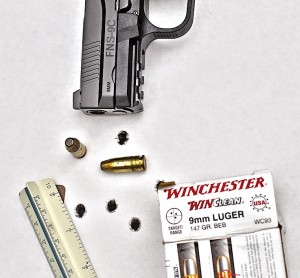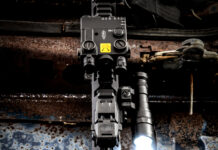Shooting the FNS-9C
Initial impression of the trigger pull: a slightly shorter, lighter take-up than the Glock, with a bit of creep to it. That is, a palpable scraping of the internal parts. This is followed by a relatively long (again, compared to the Glock) final pull, finishing with a fairly clean break that has a little backlash to it. By “backlash” I mean movement of the trigger after the sear has released. Re-set after that previous shot is about typical length for a striker-fired pistol.

I applied my Lyman digital trigger gauge (a useful item for any serious shooter; I got mine from Brownell’s). Since the pivoting trigger brings an element of leverage into play, we did one set of measurements from the toe of the trigger (more leverage = less pull weight), and another from the center, where most shooters actually put their trigger fingers. Average pull weight from the center of the trigger was 8.65 pounds, and from the toe, 7.50 pounds on the nose. Factory spec for pull weight is 5.5 to 7.7 pounds.
Next we went to the concrete bench with a Caldwell Matrix rest on the 25 yard line, with test ammo encompassing the three most popular bullet weights in 9mm. Federal 9BPLE is an old-school 115-grain +P+ jacketed hollow point, currently available from on-line ammo sellers at prices barely more than practice hardball. It earned an outstanding reputation as a “man-stopper” with Federal (U. S. Border Patrol), state (Illinois State Police), and county (DeKalb County, GA) law enforcement over the years. From the little FNS, measuring the farthest apart hits center to center, it punched five holes 3.50” apart, with the best three in 1.70”. When shooting hand-held from the bench rest, that “best three” measurement seems to compensate for unnoticed human error and give a very good approximation of what the same gun/ammo would do in a machine rest for all five shots.

Black Hills 124-grain jacketed hollow point came next. The FNS Compact put five rounds into 4.55”, and the best three in 3.40”. All measurements were done to the nearest 0.05”. Finally, we tried Winchester Winclean subsonic 147-grain full metal jacket, the most accurate low-lead cartridge I’ve found in 9mm Luger. This hit the little FNS’ sweet spot: the five-shot group was a snug 2.20”, and the best three were nine-tenths of an inch tighter at 1.30”.
Next, we went to shooting drills. In rapid fire, the palpable trigger creep seemed to disappear. The 3-dot, dovetailed fixed sights gave a good sight picture, quick to pick up in daylight. As the FNS Compact came from the factory, elevation was spot on, with 147- and 124-grain bullets hitting just a little to the right of aim, but curiously, the 115-grainers at 1,300 foot-second velocity were centered.
One thing we noticed with the FNS-9C is something common to short-gripped autoloaders with pinkie finger extensions on their stubby magazines: when we hit the mag release button, the spent mag didn’t always want to eject. Those little flanges at the bottom tend to catch on the little finger, or the heel of the hand. The full length mag dropped clear every time.
Recoil was mild, as expected. The bore axis sits higher than the Glock 26, and in slow-fire the muzzle seemed to rise just a little more—as expected—but in rapid fire, it settled right down and was back on target by the time the trigger had re-set.























